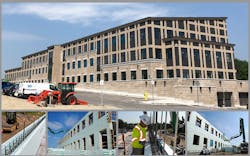How Insulated Concrete Forms Help Reduce Energy Consumption
Progressive builders and developers of homes and commercial buildings have been championing the use of insulated concrete forms (ICFs) for the past several years as a replacement for wood framing due to their countless advantages. This system is regarded worldwide as the premium choice for construction delivering building efficiencies, superior strength, insulation, conservation, and unmatched energy efficiency. Howland Green Homes’ has even taken that one step further.
Howland Green Homes’ new mission is simple: to build beyond net zero. One place this objective is to be realized is in the Canadiancity of Markham, where the company has developed the Howland Green Business Centre, a commercial building which will produce more energy than it will consume.
The First Building of Its Kind in Canada
For Dave de Sylva, president of Howland Green Homes, the future is now. This new project could set a whole new standard for environmentally conscious development that goes above and beyond the current objectives that Canadian developers are required to meet.
Net-zero energy means that a building has the ability to produce enough renewable energy on-site to match its annual needs. The practice has been increasingly realized in Ontario by several developers, and Howland Green is a pivotal example of a company that builds such developments in the Greater Toronto Area.
To go beyond net zero, or to become net positive, a building needs to generate more energy than it useseach year. According to Howland Green, this “raises the bar” in development, not only with regards to ensuring a clean ecological footprint but also in terms of economic efficiency by reducing energy-related costs with less-efficient buildings.
Behind the Energy Savings, Going Beyond the Norm
The Howland Green Business Centre was built using an enhanced insulated concrete form, the new XR35 by Nudura, which will make the building’s combined thermal resistance value considerably higher than the insulated concrete formsused in other similar structures. The XR35 increases the walls from 25/8 inches of expanded polystyrene (EPS) on each side to 4 inches, creating an estimated-value of R35, approximately three times more than what the Ontario Building Code requires and features all of the same innovative featured in the Nudura standard ICF series.
Some of the features found in Howland Green Business Centre, all of which are being done to reduce the building’s carbon footprint, include:
- R80 roof insulation.
- State-of-the-art geothermal heating and cooling.
- Full coverage of solar arrays.
- Load-sharing capabilities within structures.
- Electric potential energy storage.
- Pneumatic energy storage.
- Rainwater capture for toilet usage.
- Groundwater capture for irrigation.
- All ramps to underground parking entirely closed from the elements.
- High-efficiency dual-level LED lighting.
- Low-E Argon thermal pane insulated windows and sliding doors with fiberglass frames.
- And high-efficiency geothermal hot-water delivery with additional thermal tank wrapping.
To learn more about building beyond netzero with insulated concrete forms visit www.nudura.com or check out the Online Training Portal www.nudura.com/training-academy/online-course/ to become a trained installer of Nudura ICFs.
Nudura Inc.
27 Hooper Road, Unit 10
Barrie, ON L4N 9S3
866-468-6299
[email protected]
www.nudura.com

